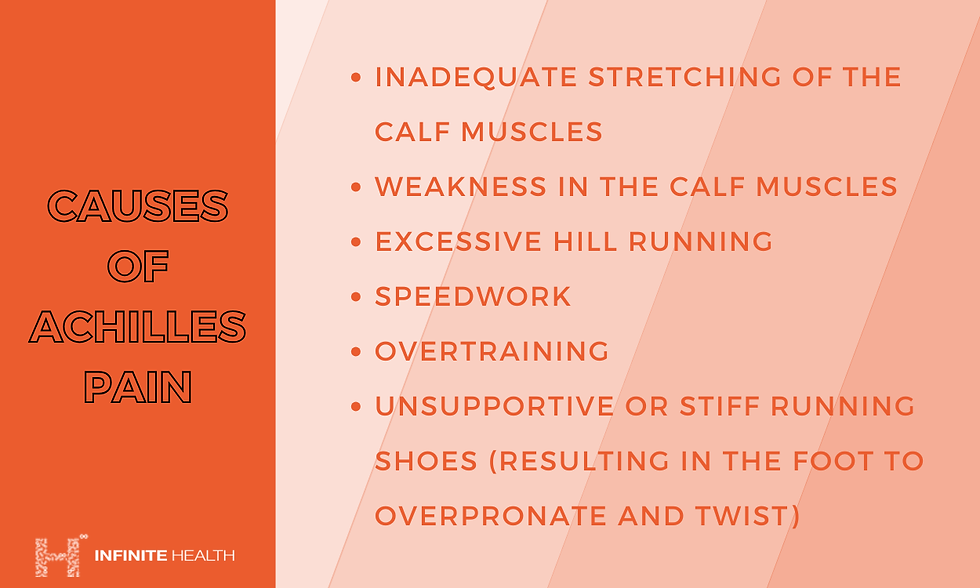Achilles Pain After Running: Common Causes & Treatment
- analytics4569
- Aug 8
- 3 min read
Achilles pain is common in runners and can crop up as a mild ache, a tight sensation along the tendon, or a sharp pain when over striding or landing. Running is naturally a repetitive movement that puts pressure on the calf muscles and the heel bone - both of which are connected to and can stress the Achilles tendon.
The Achilles tendon is the strongest tendon in the body. It is the tendon that is responsible for pushing off from the ground while walking, running, and jumping. When the Achilles tendon is weak or tight, it is put under intense strain, leading to pain or tightness. Pushing through Achilles pain can make the injury worse and lead to tendonitis, partial tear, or complete rupture of the Achilles tendon.
Seeing a physiotherapist as soon as you feel Achilles pain will alleviate and ultimately prevent Achilles pain. We can teach you how to manage the injury, and exercises to strengthen the area. The physiotherapists at Infinite Health specialise in sports-related injuries, including Achilles tendon pain, at our clinics in Chatswood, Sydney CBD, North Sydney, Mosman, and Hornsby. Our team will create a treatment plan to your specific condition and lifestyle to help you return to running pain-free.

Achilles pain after running
A sudden increase in running intensity, duration, or mileage puts the Achilles tendon and the muscles surrounding it under tension - causing the Achilles tendon to tighten and become overworked. Pain or discomfort is the first sign of a problem in the Achilles.
Achilles pain can be caused by:
Inadequate stretching of the calf muscles
Weakness in the calf muscles
Excessive hill running
Speedwork
Overtraining
Unsupportive or stiff running shoes (resulting in the foot to overpronate and twist)
Treating Achilles pain from running
The first port of call to treat Achilles pain from running is physiotherapy. Your physiotherapist will assess your Achilles pain and determine the severity of the injury, providing a tailored treatment and recovery plan.
Before your physio appointment, you can take measures at home to help alleviate the pain and (hopefully) begin the process of repairing the tendon. Resting as soon as you feel pain, icing the affected area, and taking over-the-counter anti-inflammatories will reduce swelling and inflammation in the area, which will have a direct impact on the pain experienced.
Treatment for Achilles pain generally includes:
Manual therapy
Modifications to normal activity
Stretching techniques
Physio recommended taping to unload the tendon
Using shoe inserts, such as orthotics
In more severe cases, such as a tear or rupture of the Achilles tendon, or if the pain does not improve from physiotherapy treatment, surgery may be required.

Preventing Achilles pain
After treatment, your physiotherapist will recommend some steps you can take to prevent Achilles pain from happening again down the track. These preventative steps generally include:
Strengthening exercises: Strengthening the lower-leg muscles provides a stable base for the Achilles tendon during the intense impact of running. Exercises to strengthen the ankle, foot, and calf muscles include seated heel raises, standing calf raises, walking on tiptoes, and deep squats with explosive movement to standing under guidance.
Stretching calves: Keeping the muscles around the Achilles tendon loose can release the tension on the tendon and prevent Achilles pain. Stretches include standing on a step or curb and dropping your heels down, rolling the calf muscles on a foam roller, and self-massaging the calf muscles.
Improve your running form: Landing your foot too far ahead of your body (overstriding) and landing heavy on your heels (heel striking) while running can put too much impact on the heel and muscles around the Achilles tendon. When running, focus on avoiding heavy heel strikes, shortening your stride, and quickening your cadence.
Invest in supportive running shoes: Running in worn-out, stiff shoes can cause the foot to move abnormally and place extra stress on the Achilles tendon. Invest in supportive shoes and orthotics with arch support and cushioning.
Get a running program: Running programs will avoid overusing and overloading the Achilles tendon while still achieving your running goals. A running program may include a split of easy runs, interval running sessions, long runs, and rest days.






















Players can calculate where to drop to combine, but there is still a bit of randomness when the fruit rolls and collides. The combination of skill and luck makes Suika game both challenging and surprising.